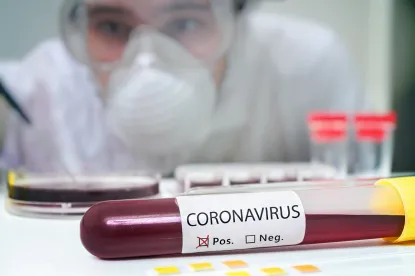The federal government declared a Public Health Emergency (“PHE”) in response to the COVID-19 pandemic effective January 27, 2020. While the health care industry has been continually adapting to new clinical information and to new regulatory challenges, one thing that has stayed constant is the need for rapid, frequent, and reliable COVID-19 laboratory testing.
At the outset, both providers and patients were led to believe that all testing would be free or paid for by insurance. Much of it is. But the ongoing nature of the pandemic has exposed gaps in this payment structure, leading to uncertainty by both providers and patients.
The goal of this article is to identify the key payment sources and to highlight ongoing issue areas. Please see the August 2020 edition of the Polsinelli Reimbursement and Payor Dispute Update to review Frequently Asked Questions related to coding and payment amounts for COVID-19 services, including testing.
Payment Opportunities for COVID-19 Laboratory Services
Rather than a streamlined national payment resource for COVID-19 testing, a patchwork of coverage and payment has grown out of federal statutes, state executive orders, state and local public health departments, and employers. The key sources are:
Commercial Payers and Federal Health Care Programs
The Families First and Coronavirus Relief Act (“FFCRA”), as amended by the Coronavirus Aid, Relief, and Economic Security (“CARES”) Act, requires most commercial health insurance plans, Medicare, Medicare Advantage, and the Medicaid program to cover COVID-19 testing — including molecular, antigen, and antibody — at no charge to the beneficiary when determined to be medically appropriate by a health care provider. This includes out-of-network commercial plans that, by statute, must pay a provider’s posted cash price for COVID-19 tests. It generally does not include non-diagnostic testing for surveillance.
HRSA Program for the Uninsured
Through funds allocated under the FFCRA and later legislation, the federal Health Resources and Services Administration (“HRSA”) also administers a reimbursement program through which providers can submit claims and receive Medicare rates for testing uninsured individuals for COVID-19. Providers do not have to submit claims to HRSA for uninsured patient.
State and Local Health Departments
State and local health departments have also established free COVID-19 testing sites, typically funded by relief funds from the federal government or through state budgets. Some are operated directly by the government while others are operated by providers under state grants or contracts.
Employers
As employers have encouraged or mandated employees to return to work, they have sought testing solutions to ensure a safe workplace. Per Equal Employment Opportunity Commission (“EEOC”) guidelines, employers are financially responsible for the cost of testing.
Unexpected Gaps and Regulatory Hurdles
Despite the availability of funding through various sources, several gaps and regulatory hurdles have made obtaining consistent payment more difficult.
Authorization and Infrastructure to Bill Payers
At the start of the PHE, many provider types were asked to join in the testing effort and encouraged to bill payers for their services. As a practical matter, though, some providers — like pharmacies — did not have the enrollments, contracts, or claims processing infrastructure to shift from billing drugs or other specialty medical services to billing for laboratory services. While the CMS fast-tracked enrollment processes to enable billing and payment from Medicare, other payers were not as quick to offer assistance and the administrative burden of adapting to new codes and billing processes has been a significant hurdle.
Non-Covered Testing
There is a wide range of reasons a particular payer may deny payment for COVID-19 testing. For example, although federal statute mandates coverage of diagnostic and antibody testing, there is on-going and legitimate concern about payment for testing asymptomatic patients with no known exposure (e.g., screening tests billed with diagnosis code Z11.59) and about whether, at some point, payers will initiate frequency limitations for repeat testing. The Department of Health and Human Services (“HHS”) has explicitly said that the FFCRA does not require payers to cover screening tests for general workplace safety, for public health surveillance, or for “any other purpose not primarily intended for individualized dialysis or treatment of COVID-19 ... ” Based on these concerns, providers offering tests are well-served to develop protocols for testing that follow HHS and Centers for Disease Control and Prevention (“CDC”) guidelines.
Mandatory Testing for Long-Term Care Facilities
CMS recently instituted a mandatory testing obligation for staff and residents of certified long-term care facilities, something that had already been required by many state-level executive orders or department of health directives. Despite the potential cost of testing, which can be required as frequently as twice per week in areas experiencing high COVID-19 rates, CMS offered no options for reimbursement (besides coverage otherwise available through insurance). Sometimes, states have offered payment for a baseline test of all staff and residents, but not recurring tests, and others have offered payment on an invoice basis, but only after the facility seeks payment from all other possible payers. Even when reimbursement is available through an invoice process, sometimes only the facility itself can submit the invoice, so if it contracts with a third-party lab for testing, there is a significant burden to coordinating patient information, billing, and denial confirmations. All in all, there is the potential for facilities to incur tremendous costs for an indefinite period, and both state and federal governments may need to act to resolve the uncertainty around payment.
Patient-Directed or Self-Pay COVID-19 Testing
Laboratories and other testing providers are also confronting new regulatory challenges associated with patients seeking COVID-19 testing independently, without a practitioner order, and when either the provider or the patient wants to pursue testing on a self-pay basis. The lack of a physician order can present issues under both FDA requirements, as the Emergency Use Authorizations typically call for testing to be done upon the order of a qualified person, and state laws, which may not permit so-called “direct access testing.” In other scenarios, either the lab services provider wants to offer testing exclusively on a self-pay basis (to avoid the uncertainty around payer coverage) or a patient may seek testing on a selfpay basis. Although often patients may agree to pay out-of-pocket, Medicare and Medicaid-participating providers (in particular) must grapple with mandatory claim submission provisions, which require a claim to be submitted on the patient’s behalf for any covered services. Whether and to what extent these regulatory hurdles come into play depends on the facts, but they are nonetheless potential barriers to patient access and to payment.




 />i
/>i

